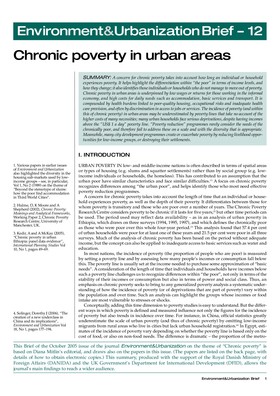
A concern for chronic poverty takes into account how long an individual or household experiences poverty. It helps highlight the differentiation within “the poor” in terms of income levels, and how they change; it also identifies those individuals or households who do not manage to move out of poverty. Chronic poverty in urban areas is underpinned by low wages or returns for those working in the informal economy, and high costs for daily needs such as accommodation, basic services and transport. It is compounded by health burdens linked to poor-quality housing, occupational risks and inadequate health care provision, and often by discrimination in access to jobs or services. The incidence of poverty (and within this of chronic poverty) in urban areas may be underestimated by poverty lines that take no account of the higher costs of many necessities; many urban households face serious deprivations, despite having incomes above the “US$ 1 a day” poverty line. “Poverty reduction” programmes rarely consider the needs of the chronically poor, and therefore fail to address these on a scale and with the diversity that is appropriate. Meanwhile, many city development programmes create or exacerbate poverty by reducing livelihood opportunities for low-income groups, or destroying their settlements.
Brief of the October 2005 issue of E&U (Vol 17:2)
Cite this publication
Available at https://www.iied.org/10539iied